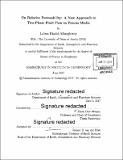On relative permeability : a new approach to two-phase fluid flow in porous media
Author(s)
Albarghouty, Lubna Khalid
DownloadFull printable version (12.35Mb)
Other Contributors
Massachusetts Institute of Technology. Department of Earth, Atmospheric, and Planetary Sciences.
Advisor
Frank Dale Morgan.
Terms of use
Metadata
Show full item recordAbstract
Being valid for single-phase flow, Darcy's law is adapted to two-phase flow through the standard approach of relative permeability, in which permeability, rather than being a unique property of the porous medium, becomes a joint property of the porous medium and each fluid phase. The goal of this study is to find a proper, alternate approach to relative permeability that can describe two-phase flow in porous media while maintaining sound physical concepts, specifically that of a unique permeability exclusive to the porous medium. The suggested approach uses the concept of an average viscosity of the two-phase fluid mixture. Viscosity, the only fluid-characterizing term in Darcy's law, should -at least partially- explain two-phase flow behavior by becoming the two-phase flow property that varies with the saturation ratio of the two fluid phases. Three common mathematical averages are tested as potential viscosity averages. Aspects of two-phase flow in pipes are then considered to see whether two-phase flow behavior in porous media can be attributed to the fluid mixture alone. Total flow rate of the two-phase fluid mixture is modeled by using the fluid mixture average viscosity in Darcy's law. Using two-phase flow data from Oak et al. (1990a, 1990b), the harmonic average weighted by the reduced fluid saturations represents the average viscosity of liquid-gas mixtures in steady-state flow in imbibition. Extracting flow rates of the individual phases from the total flow rate of the fluid mixture is the next, but crucial, step that determines whether the average viscosity approach can replace that of relative permeability in solving common reservoir engineering problems. Liquid-liquid flow in both drainage and imbibition, and liquid-gas flow in drainage are not represented by a simple viscosity average, which indicates the need for further study into more complex viscosity averages.
Description
Thesis: S.M. in Geophysics, Massachusetts Institute of Technology, Department of Earth, Atmospheric, and Planetary Sciences, 2017. Cataloged from PDF version of thesis. Includes bibliographical references (pages 115-116).
Date issued
2017Department
Massachusetts Institute of Technology. Department of Earth, Atmospheric, and Planetary SciencesPublisher
Massachusetts Institute of Technology
Keywords
Earth, Atmospheric, and Planetary Sciences.